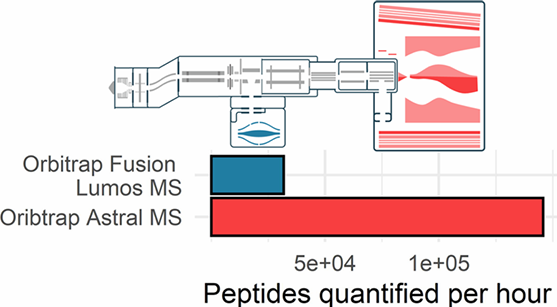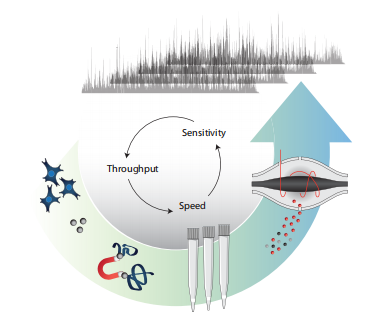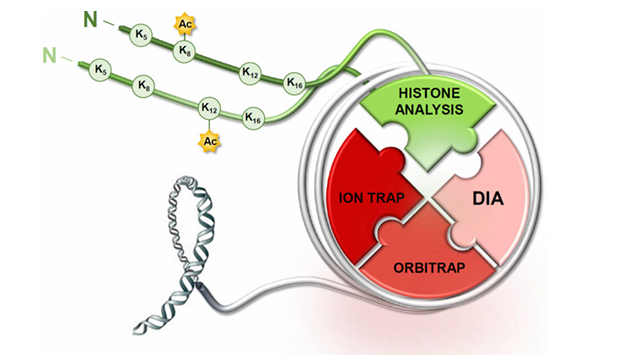DIA Mass Spectrometry Service
Data-independent acquisition mass spectrometry (DIA mass spectrometry) is a powerful tool for detecting and filling gaps in traditional data-dependent acquisition (DDA). With the rapid development of mass spectrometry technology and software analysis technology, it has also been favored by more omics users. DIA mass spectrometry service Compared with the sequential detection, selection and analysis of individual ions in the DDA acquisition mode, the DIA mode can acquire fragment ions of all detectable ions in a wide m/z range, regardless of their intensity. This provides a wider detection dynamic range (cytomics dynamic range: 7 orders of magnitude; body fluidomics dynamic range: 10 orders of magnitude), improves identification reproducibility, quantitative sensitivity and accuracy, and potentially enhances Proteome coverage.
The DIA mass spectrometry service provides strong technical support for proteomics detection dynamic range width, omics quantitative repeatability, and low-abundance protein detection. If you want to do your job, you must first sharpen your tools. The reason why the DIA acquisition mode can be quickly and widely used is inseparable from the rapid development of mass spectrometry technology. The Thermo Scientific Orbitrap series of mass spectrometers has long been the gold standard for high-resolution proteomics, combining the advantages of high resolution, high sensitivity and accuracy. However, in order to meet the increasing needs of proteomics, a new mass spectrometer Orbitrap Astral was born, ranking first with its near-lossless ion transmission and acquisition speed of 200 HZ.

LilianR. Heil. et al. Journal of Proteome Research. 2024.
Figure 1. Comparison of Peptide Quantification Capabilities of Different Mass Spectrometers
Services at MtoZ Biolabs
Leveraging multiple mass spectrometry platforms (QE, OE, Astral) and precise DIA quantitative proteomics data analysis, the DIA mass spectrometry service provided by MtoZ Biolabs can conduct comprehensive analysis of samples (cells, tissues, body fluids) in multiple sample. Our services primarily focus on two key areas:
1. Data Acquisition
MtoZ Biolabs uses multiple Orbitrap series mass spectrometers and Astral mass spectrometers as equipment support. Based on DIA mode, mass spectrometry parameters set dynamic windows. According to different retention times, materials flow out, and different width windows are set to collect data, and the entire mass is analyzed. Accurate adjustment based on the range of detection data. While maintaining high resolution, high accuracy and high sensitivity, it can also ensure high sample throughput and high quality of data.
2. Data Analysis
Based on bioinformatics technology, MtoZ Biolabs can accurately analyze large amounts of complex data generated by DIA mass spectrometry service and produce a full set of omics data charts.
Analysis Workflow

Bekker Jensen et al. Molecular & Cellular Proteomics, 2020.
Figure 2. DIA Workflow
Service Advantages
1. Multiple Mass Spectrometers
MtoZ Biolabs has multiple Thermo high-resolution mass spectrometers, ensuring that its DIA mass spectrometry service meet the demands for depth, speed and high accuracy in data acquisition.
2. Transparent Pricing
Our pricing is transparent with no hidden fees or extras.
3. High-Quality Data
By using more reasonable experimental protocols and methods, we provide customers with higher-quality omics data, and provide more comprehensive data reports and charts through bioinformatics technical analysis.
4. Customized Research Solutions
MtoZ Biolabs can customize personalized services based on samples to solve your different research questions and experimental requirements.
Sample Submission Suggestions
1. Sample Types
We can receive multiple dimensions of sample types, including different animal and plant samples (cells, tissues, body fluids, etc.)
2. Sufficient Sample Preparation
*Note: For any specific requirements or assistance with sample preparation, please contact us.
Applications
1. Medical Research
Biomarker discovery and validation; Disease mechanism research; Drug target identification.
2. Biological Research
Apoptosis studies; Mitochondrial proteomics research.
3. Agricultural Research
Crop stress resistance research; Crop quality improvement.
4. Biopharmaceutical Research
Drug discovery and screening.
Case Study
1. Non-Targeted Analysis of Histone Modifications Using DIA Mode
Using DIA mode and low-resolution MS can perform histone modified peptide analysis. In addition to having high peptide quantification accuracy and precision, it can also identify and quantify unknown modified peptides through data mining.

Simone Sidoli. et al. Anal Chem, 2015.
Figure 3. Workflow of DIA Quantitative Proteomics for Histone Modifications
Deliverables
1. Comprehensive Experimental Details
2. Materials, Instruments, and Methods
3. Total Ion Chromatogram & Quality Control Assessment (project-dependent)
4. Data Analysis, Preprocessing, and Estimation (project-dependent)
5. Bioinformatics Analysis
6. Raw Data Files
MtoZ Biolabs, an integrated Chromatography and Mass Spectrometry (MS) Services Provider, provides advanced proteomics, metabolomics, and biopharmaceutical analysis services to researchers in biochemistry, biotechnology, and biopharmaceutical fields. Our ultimate aim is to provide more rapid, high-throughput, and cost-effective analysis, with exceptional data quality and minimal sample consumption. Free project evaluation, welcome to learn more details!
How to order?







